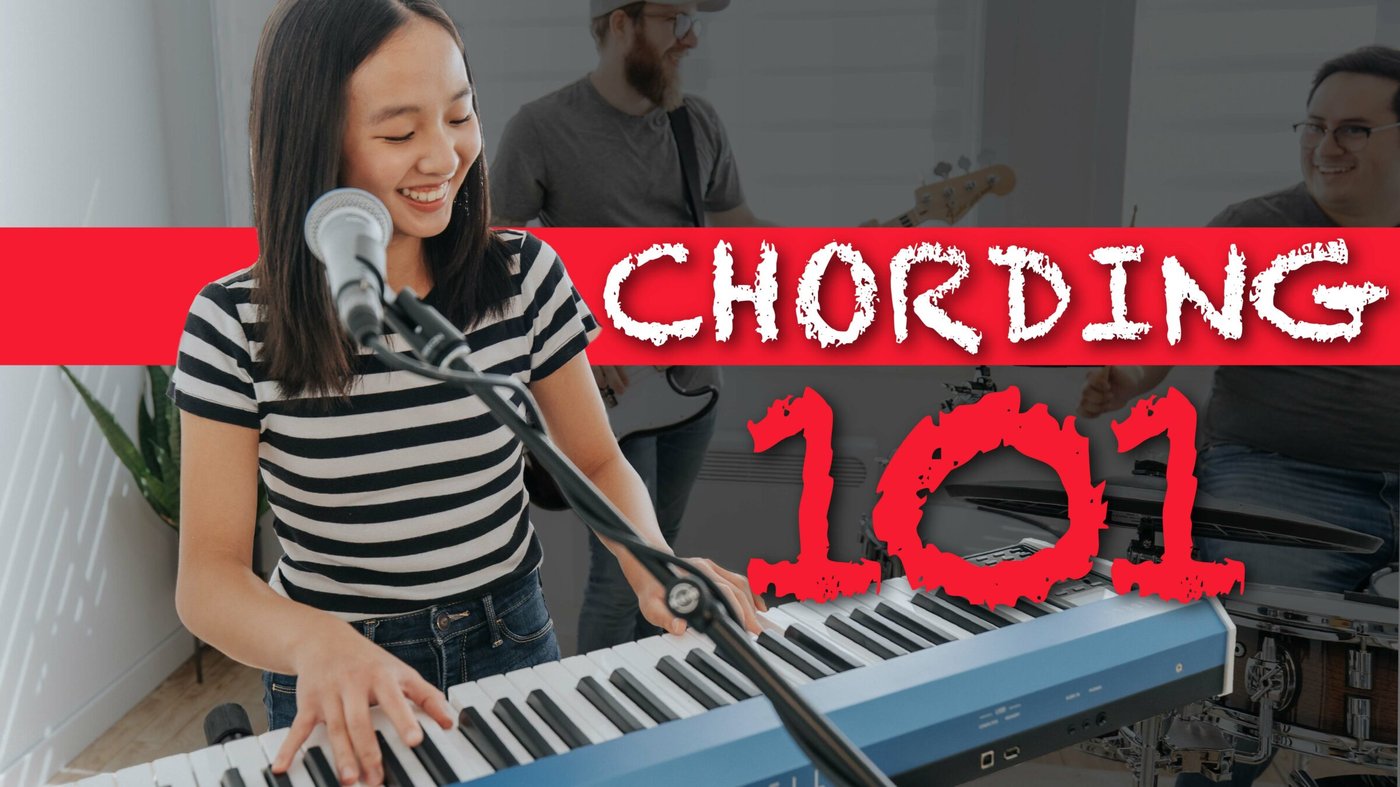
Chords form the foundation of Western music (pop, jazz, classical, folk, rock—you name it!). So, understanding piano chord theory is worth the time and effort. And you don’t even need to be an expert sight reader to learn this.
In this lesson, we’ll give you a high-level introductory look at piano chord theory. We have a ton of free resources on chords because they’re that important, so we’ll also direct you to exercises and tips you can explore as next steps.
Table of Contents:
Inspiring tutorials. Fascinating articles. Exclusive interviews. We create piano content anyone, anywhere can enjoy for free. Don’t miss out, sign up for more free lessons.
So, what’s the big deal with chords?
Well, chords are what allow us to form melodies and harmonize. Underlying any song structure is a chord progression.
The presence of chords may not be immediately obvious when you look at a piece of music, but once you learn how to identify them, you’ll start to see chords everywhere. And not just in pop songs. Take a look at the first few measures of “Für Elise”—it’s made up of E major and A minor chords!

Another great thing about chords is you don’t necessarily need to know how to read sheet music to play your favorite songs. All you need is a chord chart, and chord charts are easily findable in places like Ultimate-Guitar.com.
As piano players, we play both the melody and harmony when we play songs. This means piano players need a good understanding of piano chord theory in order to play full, lush harmonies on our instrument.
> Why We Love Chords (The Foundations of Music)
Before you learn piano chord theory, get familiar with scales and intervals. These concepts and chord theory build on each other.
A scale is a set of pitches organized by a formula or set of rules. For example, a major scale follows a formula of whole and half steps.
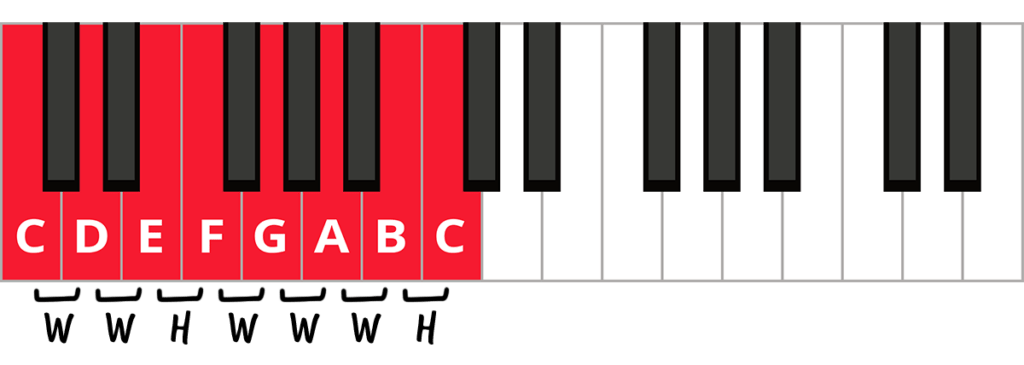
Scales in major and minor keys follow that key’s key signature. For example, an F major scale has one flat (B♭), so every time you play a scale or song in F major, flat the B unless otherwise indicated.

You can think of a scale as a “bank” of notes from which we craft melodies, harmonies, and improvise. There are many types of scales, but if you’re just getting started on chords, understanding your major and minor scales is sufficient.
> Piano Scales: Types of Scales and How to Apply Them
An interval is the space between two notes. There are several ways to think about them.
You can think of intervals in terms of whole and half steps. You can also think about them in relation to a scale. For example, a major 3rd interval starting on C is the first and third note of the C major scale. And a minor 3rd interval starting on C is the first and third note of the C minor scale.
For a more intuitive approach, you can associate intervals with a song. Each interval has a distinct sound. Here are some intervals with C as the root (starting) note and a song that’s commonly associated with it.
| Interval | Formula (Based on Major Scale) | Songs |
|---|---|---|
| Minor 2nd | 1-♭2 | Jaws theme, Für Elise (Beethoven) |
| Major 2nd | 1-2 | Happy Birthday, Mama Mia (ABBA) |
| Minor 3rd | 1-♭3 | Spider-Man theme, Hey Jude (the Beatles) |
| Major 3rd | 1-3 | When the Saints Go Marching In, Summertime (Gershwin) |
| Perfect 4th | 1-4 | Summer Nights (from Grease), Under Pressure (Queen) |
| Tritone | 1-#4 / 1-♭5 | YYZ (Rush) |
| Perfect 5th | 1-5 | Star Wars theme, Minuet in G Major (Bach) |
| Minor 6th | 1-♭6 | The Entertainer (Scott Joplin) |
| Major 6th | 1-6 | My Way (Frank Sinatra), Man in the Mirror (Michael Jackson) |
| Minor 7th | 1-♭7 | Can’t Stop (Red Hot Chili Peppers), Shadow of Your Smile (theme from The Sandpiper) |
| Major 7th | 1-7 | Take On Me (A-ha), I Love You (Cole Porter) |
| Octave | 1-8 | Over the Rainbow (from The Wizard of Oz), Someone to Watch Over Me (Gershwin) |
The first type of chord you should learn how to build on the piano is a triad. A triad is a chord made up of three notes. Major and minor triads are piano chords that you’ll find in almost every single song. Major triads sound “happy” and minor triads sound “sad.”
A chord is made up of a group of notes played together, and each note in the “stack” has a name:
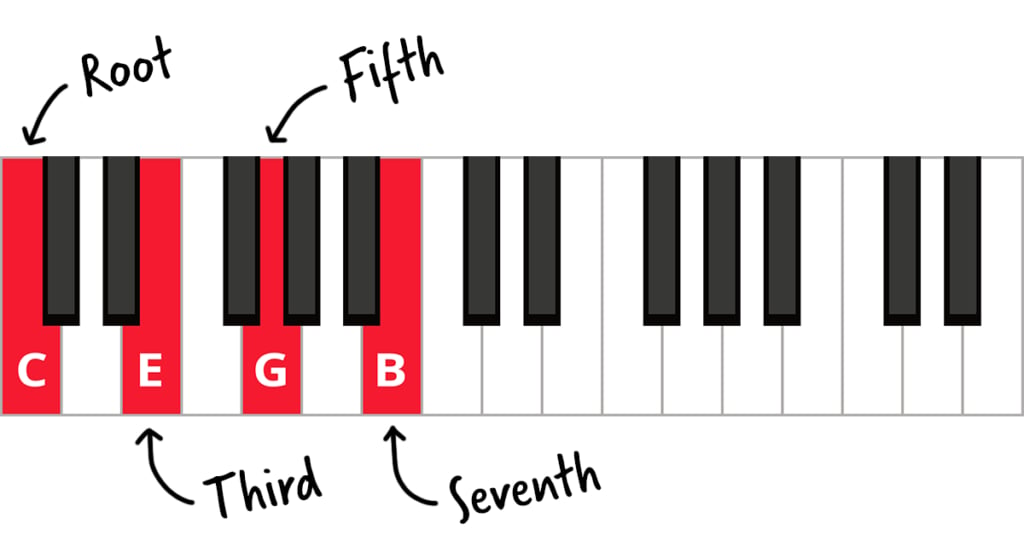
To build a major triad, find the notes a major 3rd and perfect 5th above your root. You can also think of a major triad as four half-steps between the root and the third, and three half-steps between the third and the fifth.
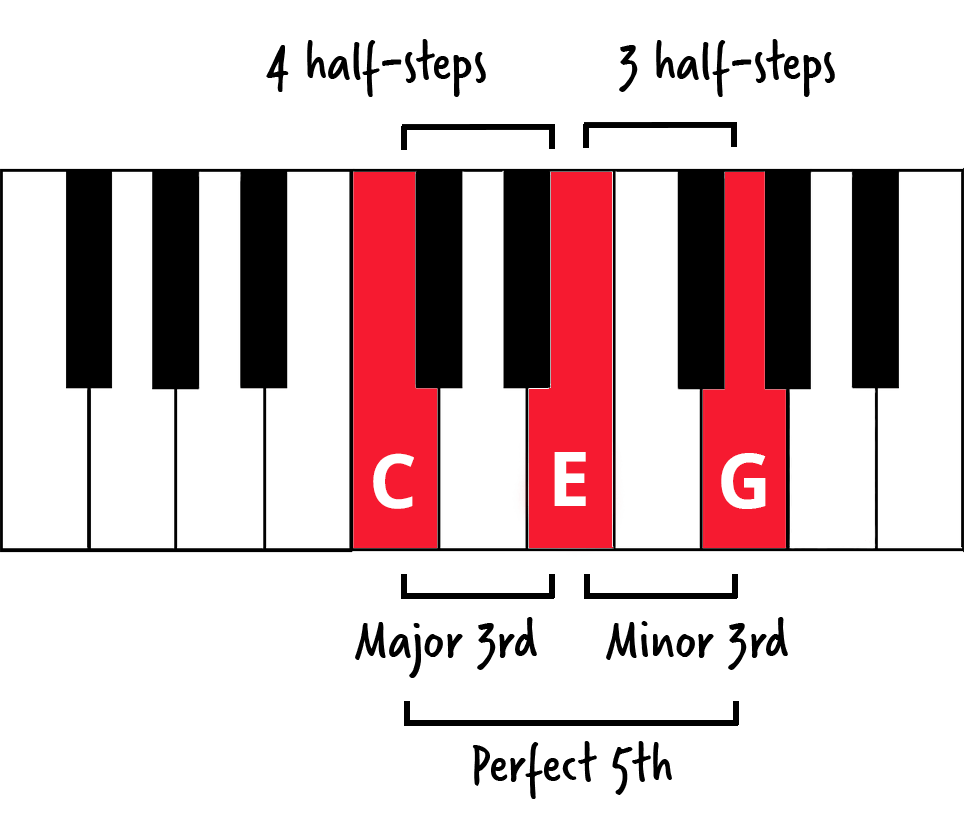
To build a minor triad, find the notes a minor 3rd and perfect 5th above your root. You can also think of a minor triad as three half-steps between the root and the third, and four half-steps between the third and the fifth.
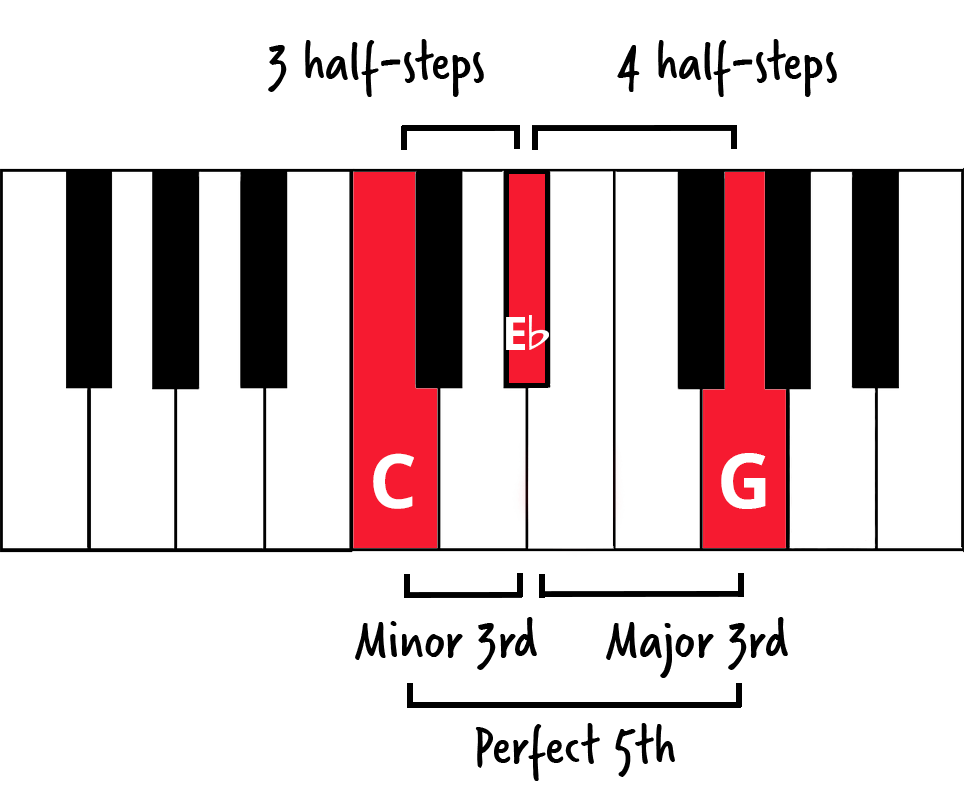
Here’s another way to think about triads: a major triad is the first, third, and fifth note of the root note’s major scale. And a minor triad is the first, third, and fifth note of the root note’s minor scale!
7th chords have a dreamy, colorful sound. If you plan to play jazz piano, 7th chords are a must-know piano chord theory concept.
In a nutshell, a 7th chord is when you add a fourth note to a three-note triad stack. This note is a major or minor seventh above the root. You’ll notice that the sound is slightly dissonant—that’s the point! 7th chords are used to add tension to a song. Tensions add depth, complexity, and sophistication to harmonies.
Now, there are several different types of 7th chords. The ones you’ll run into most are major 7th chords, minor 7th chords, and dominant 7th chords.
To build a major 7th chord, take a major triad and add a major seventh interval on top.
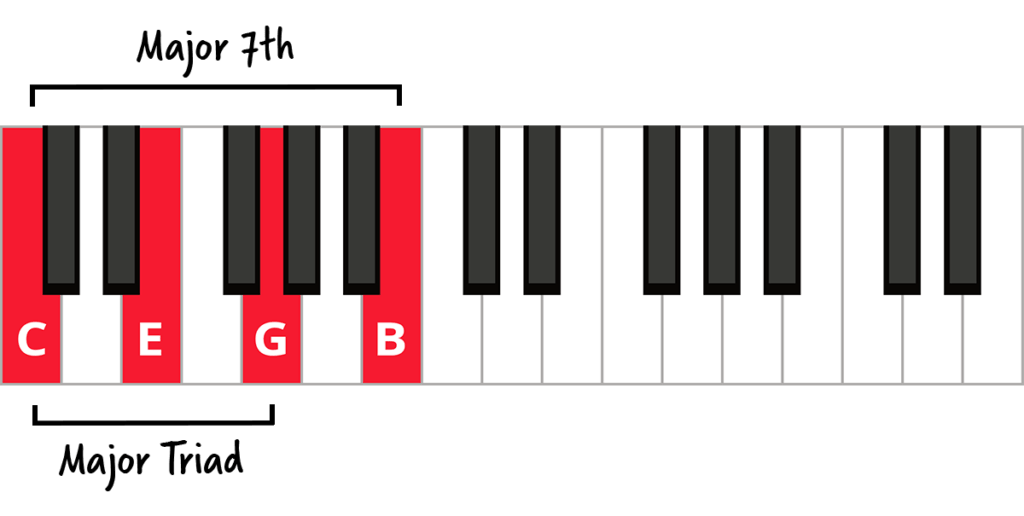
To build a minor 7th chord, take a minor triad and add a minor seventh interval on top.
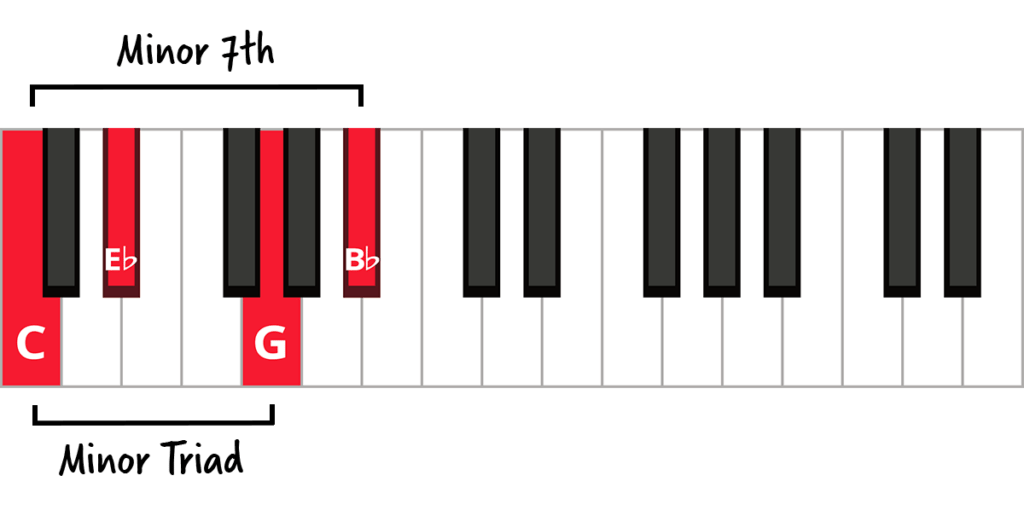
To build a dominant 7th chord, take a major triad and add a minor seventh interval on top.
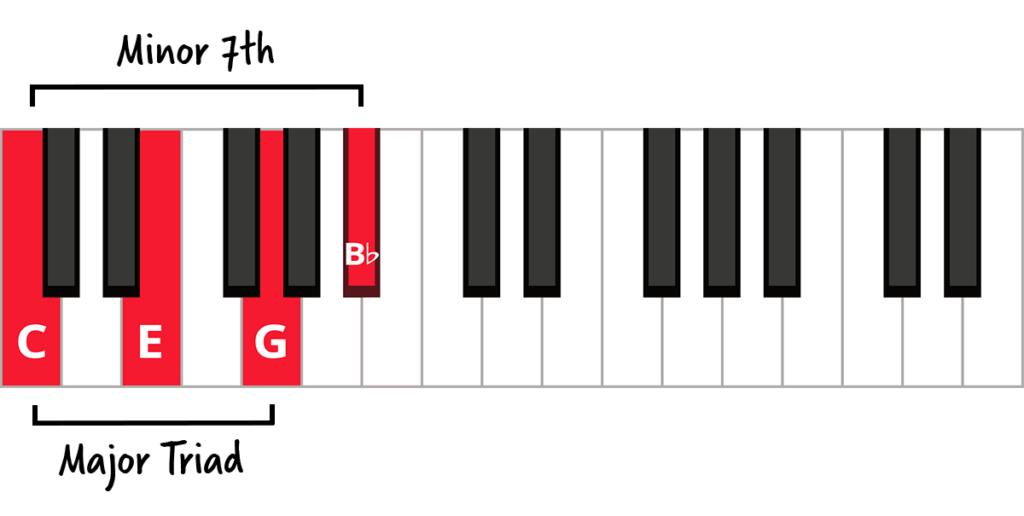
The reason why we add a minor seventh is because the dominant 7th is a chord built on the fifth note of the major scale and follows the key signature of that scale.
So, a dominant 7th chord built on C belongs to a scale in which C is the fifth note. That scale is F major, and F major has one flat (B♭), so we add a B♭ to our 7th chord.
Once you’re comfortable with major, minor, and dominant 7th chords, start exploring diminished and half-diminished 7th chords.
For an in-depth discussion about different types of 7th chords, including diagrams in all twelve keys, check out our Ultimate Guide to 7th Chords on Piano.
Understanding diatonic chords will help you find chords that sound good together.
Diatonic chords are chords that occur naturally in a scale. In other words, they are chords built on each degree of the scale and follow that scale’s key signature.
For example, in C major, D is the second degree of the C major scale. If we build a triad on D (and follow C major’s key signature), we get Dm (D-F-A). So, the D minor triad (“Dm”) is a diatonic chord in the C major scale.
You can find all the diatonic chords of a scale by scooching your hand position up through the scale, like this:
On sheet music, diatonic chords look like this:

Notice how we use Roman numerals to number these chords. We’ll talk more about this in the number system section, but in short, we use Roman numerals to represent degrees of the scale. Uppercase letters represent major chords and lowercase letters represent minor and diminished chords. The “o” represents a diminished triad—where all notes of the triad are a minor third apart.
In summary, these are our diatonic chords in C major:
| Scale Degree | Chord | Chord Notes |
|---|---|---|
| I | C-E-G | C |
| ii | D-F-A | Dm |
| iii | E-G-B | E |
| IV | F-A-C | F |
| V | G-B-D | G |
| vi | A-C-E | Am |
| viio | B-D-F | Bdim |
In general, chord progressions use diatonic chords in that song’s key. So if you’re trying to figure out the chords in a song, try diatonic chords in that song’s key first.
Until now, we’ve been learning the root position of chords. This is when the root note is at the very bottom of a chord stack.
But we don’t have to play chords in root position all the time. We can invert chords, which means switching up the order of the notes in a chord.
To invert a chord, take the note at the very bottom of the stack and flip it to the top. For example, the root position of a C major triad is C-E-G. The 1st inversion of this chord is E-G-C, and the 2nd inversion of this chord is G-C-E.
Root Position

1st Inversion

2nd Inversion

Note that 1st inversion is not the first position of this chord. Root position is.
Inversions are useful because they give you a variety of ways to play the same chord. With inversions, you create the same harmonic effect as a root position chord with a slight difference in sound. These simple changes can make a song sound a lot more interesting.
Inversions can also serve as a shortcut between chords. For example, jumping from the root position of C Major to the root position of F Major is a bit of a leap.
BUT, moving from a C major triad in root position to an F major triad in 2nd inversion is a piece of cake. Right next door!
The best way to practice and get familiar with inversions is to memorize shapes, not notes. Inversion shapes are consistent across keys.
You can find more practice tips and a downloadable set of inversion chord charts here.
By now, you understand basic piano chord theory behind triads, 7th chords, and inversions. Hooray!
But we can do even more with chords. If you play with chord charts, you’ll eventually run into chords that look like this:
Let’s see what these mean…
Slash chords look weird, but they’re straightforward to decipher.
The first letter to the left of the slash is the chord you’re playing. Usually, we play this with our right hand.
The letter to the right of the slash is the note you’ll play in the bass with your left hand. So, the slash essentially means “play this chord over this note.”
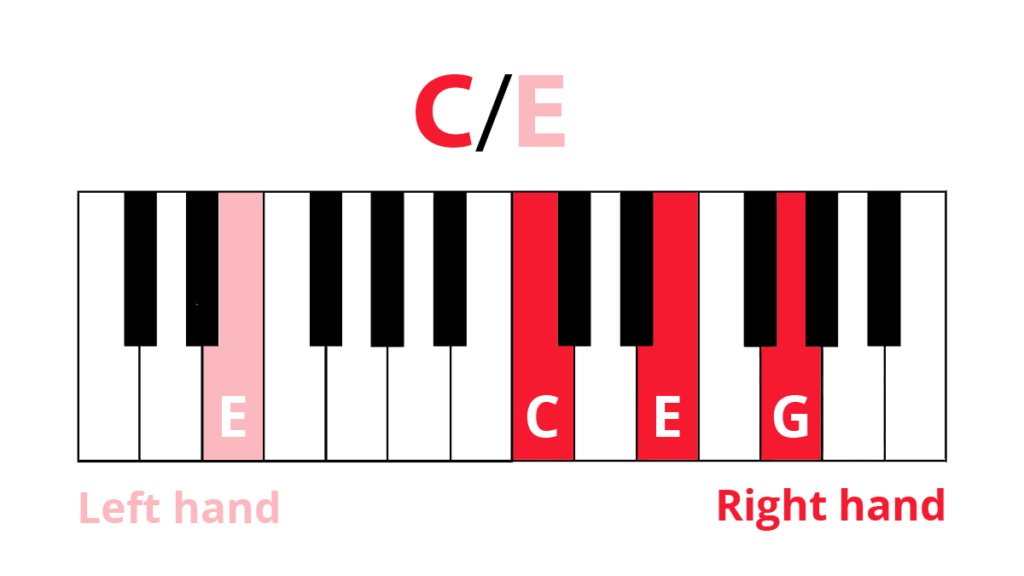
Slash chords are one way to notate inversions in chord charts. For example, C/E indicates a C major chord in first inversion.
The “sus” stands for “suspended” and it simply means to substitute the middle note of a chord (the third) for something else.
There are two types of sus chords, sus2 and sus4. In a sus2 chord, we substitute the third with the second note from the root. In a sus4, we substitute the third with the fourth note from the root.
Csus2

Csus4

Because sus chords have no third, they are neither major nor minor. This makes them sound ambiguous—sometimes in a good and interesting way!
Sus chords can sound unresolved, though, so a good rule of thumb is to return to the non-sus chord and end on that. For example, if you have a C major triad for four beats, you can play a sus chord on the third beat for an extra splash of color, then land back on the major triad for the fourth beat.
Triads are three-note chords. 7th chords are four-note chords. But we can keep adding notes to the chord stack. When we go beyond sevenths, we’re adding chord extensions.
So, if we take a dominant 7th chord like C7 and keep adding extensions, we’ll get C9, C11, and C13.
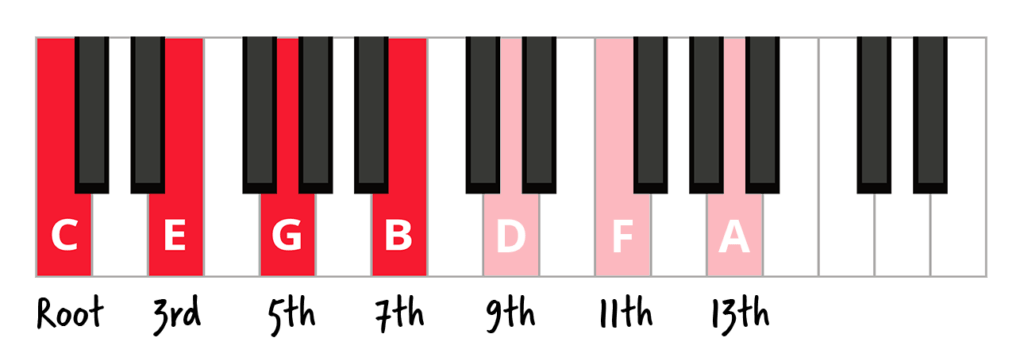
Note that pianists typically don’t play all these notes at the same time! When it comes to extensions, we usually omit some notes and use inversions. This is called chord voicing.
You can learn more about chord extensions in detail here.
Remember when we numbered degrees of the scale when we talked about diatonic chords? This is the number system in action.
Referring to chords using numbers rather than chord names allows musicians to communicate chord progressions without being tied to a specific key.
For example, take this chord progression in the key of C major:
C – G – Am – F
Now let’s turn it into numbers. Uppercase letters represent major chords and lowercase letters represent minor or diminished chords:
I – V – vi – IV
Say we want to transpose our song into G major. All we have to do is find the I, V, vi, and IV chords in G major:
G – D – Em – C
The number system is useful in ensembles such as worship bands. For example, you can play in one key for a children’s choir during the morning service, and another key for a grown-up choir during the afternoon service without having to write new sheet music!
You can learn more about the number system in this lesson.
A chord progression is a sequence of chords that sound good together. Chord progressions are what songs are made of. The movement of chords evoke tension, narrative, and, when chords resolve, a sense of completeness.
There are popular progressions that you’ll find again and again. Here are a few.
This progression is the most common progression in pop music. Once you learn this progression, you’ll start seeing it everywhere. Here it is in C major:
C – G – Am – F
Songs that use the I-V-vi-IV progression include:
This progression is built on the second, fifth, and first note of the scale. When played using 7th chords, this is the most common progression in jazz music. In C major, the chords are:
Dm7 – G7 – Cmaj7
Songs that use the ii7-V7-I7 progression include:
Fun chord progressions you can explore include:
Get an in-depth lesson in chord progressions here.
Inspiring tutorials. Fascinating articles. Exclusive interviews. We create piano content anyone, anywhere can enjoy for free. Don’t miss out, sign up for more free lessons.
A chord chart is a document with the lyrics of a song and the corresponding chord changes on top.
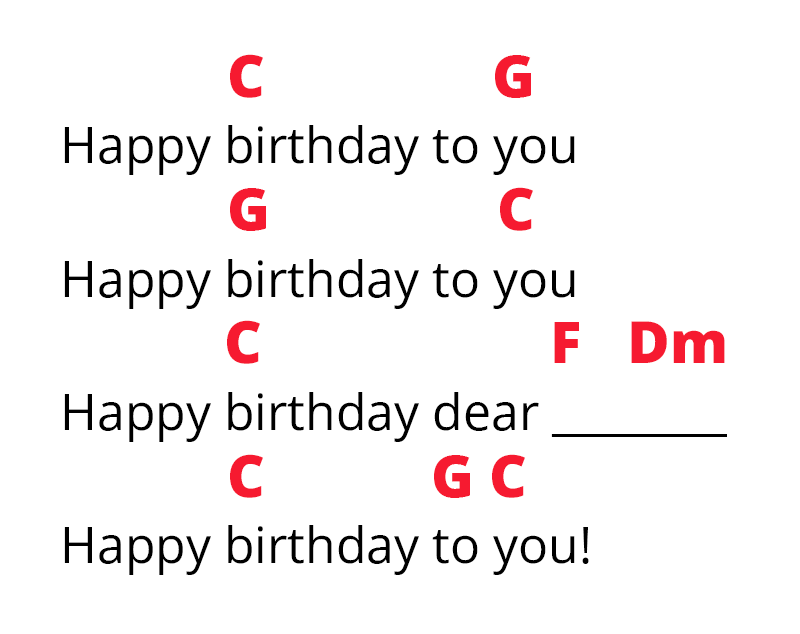
A lead sheet is a document with the melody line notated in standard notation and the corresponding chord changes on top.

Chord charts and lead sheets are useful tools because they 1) are widely available; and 2) give you guiding structure while allowing space for creative improvisation.
Do note that many free chord charts on the Web are notated by amateur musicians, not the artists themselves. (Original chord charts tend to be paywalled.)
So, there may be errors. But if something sounds wrong, trust your gut and see if you can figure out the right chord yourself! (Hint: Try diatonic chords!)
Chord symbols can be intimidating for beginners. Luckily, you can toggle a chord chart to “piano” on Ultimate-Guitar.com and it will show you where to place your fingers for each chord.
As a quick reference, here are some examples of chord symbols you may see:
| Chord Symbol | Type of Chord | Formula (based on major scale) |
|---|---|---|
| C, Cmaj | Major triad | 1-3-5 |
| Cm, C- | Minor triad | 1-♭3-5 |
| Caug, C+ | Augmented triad | 1-3-#5 |
| Cdim, Co | Diminished triad | 1-♭3-♭5 |
| C6 or Cm6 | 6th chord | 1-3-5-6; 1-♭3-5-6 |
| C/E | Slash chord | C major triad over E |
| Csus2, Csus4 | Suspended chord | 1-2-5; 1-4-5 |
| Cmaj7, CΔ | Major 7th chord | 1-3-5-7 |
| Cm7, C-7 | Minor 7th chord | 1-♭3-5-♭7 |
| C7 | Dominant 7th chord | 1-3-5-♭7 |
| Cdim7, Co7 | Diminished 7th chord | 1-♭3-♭5-♭♭7 |
| Cm7♭5, Cø7 | Half-diminished 7th chord | 1-♭3-♭5-♭7 |
All these theory rules and chord formulas can feel overwhelming. That’s valid! You may be dreading the memorization process now, but the best way to remember chord theory is to play chords. Here are some exercises you can try out:
This is the way classical pianists have practiced chords for generations. Pick a chord and then play the chord and its inversions up and down one or two octaves. “Solid” practice is when you play a sequence of chords with all the notes together. “Broken” practice is when you play a sequence of chords with the notes apart.
Solid Practice
Broken Practice
You can also do this with diatonic chords.
Make sure you practice chords in all twelve keys. Do a key a day!
Inversions are a handy way to shortcut the transition between two chords.
There are tons of combinations you can use to transition using inversions. This can feel intimidating, so we suggest focusing on a few key progressions that are common:
Let’s face it: chord practice can get boring. But arpeggiated chords sound beautiful, impressive, and they do a good job at training your dexterity.
These arpeggio exercises are designed to be stimulating and fun, not monotonous and boring. Try some!
What if I were to tell you that all the music you are playing and enjoying is entirely built up of chords…and if you learn to identify these chords, not only will you be able to read music so much faster, you’ll also be able to improvise, create your own music, and play basically any song you hear on the radio.
Lisa Witt, “Why We Love Chords”

Congratulations! You’ve just mastered basic piano chord theory.
This is a big moment. By understanding chords, you’ve unlocked a core concept in music and piano playing.
Now go download some chord charts and play some songs!
The best way to learn piano is with real teachers, but not everyone has the time and money for a private instructor. At Pianote, you can get real feedback from real experts…all from the comfort of your own home. Explore our Method and community yourself with a free 7-day trial.
TRY PIANOTE FOR 7 DAYSCharmaine Li is a Vancouver writer who has played piano for over 20 years. She holds an Associate diploma (ARCT) from the Royal Conservatory of Music and loves writing about the ways in which music—and music learning—affects the human experience. Charmaine manages The Note. Learn more about Charmaine here.


By signing up you’ll also receive our ongoing free lessons and special offers. Don’t worry, we value your privacy and you can unsubscribe at any time.
We use cookies for traffic data and advertising. Cookie Policy »